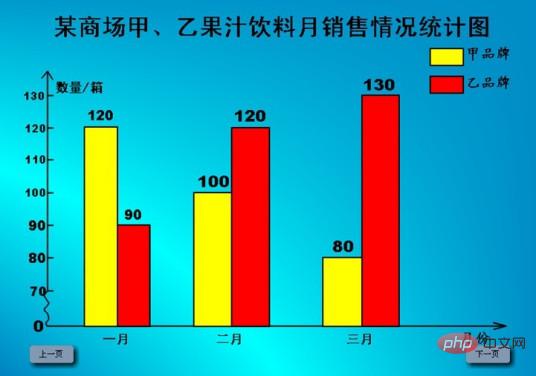Bar charts use "straight bars" to present data. A bar chart uses one unit length to represent a certain quantity. Straight bars of different lengths are drawn according to the quantity, and then these straight bars are arranged in a certain order. It is easy to see various types of bars from the bar chart. Quantity. Bar charts are divided into: single bar chart and compound bar chart. The former only represents the data of one item, while the latter can represent the data of multiple items at the same time.

The operating environment of this tutorial: Windows 7 system, Dell G3 computer.
Statistical tables present data in "numbers". Bar charts present data as "straight bars."
Introduction to bar charts
The bar chart uses one unit length to represent a certain quantity. According to the quantity Draw straight bars of different lengths and then arrange these straight bars in a certain order. It is easy to see the magnitude of various quantities from a bar chart. Bar charts are generally referred to as bar charts, also called bar charts or histograms. Example:

Classification:
Bar charts are divided into: single bar chart and compound bar chart Graphical statistical chart, the former only represents the data of one project, while the latter can represent the data of multiple projects at the same time.
Frequency: Generally, we call the number of data falling in different groups the frequency of the group (frequency)
Frequency: The ratio of frequency to the total number of data is frequency, frequency × 100% is percentage.
Applicable:
Bar charts are mainly used to represent discrete data, that is, count data.
The same thing between single bar chart and compound bar chart is that both can make people clearly see the quantity. The difference is that a single bar chart is used to compare one object, while a compound bar chart is used to compare the quantities of multiple objects.
Under the same conditions, n tests are conducted. In these n tests, the number of times event A occurs nA is called the frequency of event A. The ratio nA/n is called the frequency of occurrence of event A, and is recorded as fn(A). It is defined in text as: the ratio of the number of occurrences of each object to the total number of times is the frequency.
⒈When the number of repeated tests n gradually increases, the frequency fn(A) shows stability and gradually stabilizes at a certain constant. This constant is the probability of event A. This "frequency stability" This is commonly referred to as statistical regularity.
⒉Frequency is not equal to probability. According to Bernoulli's theorem of large numbers, when n tends to infinity, frequency fn(A) is close to probability P(A) in a certain sense.
The relative frequency m/n of a random event occurring m times in n trials. In general physical science, frequency refers to the number of vibrations per second, which can be random or deterministic.
Under certain conditions, the object under study is observed or tested. Each time a condition group is realized, it is called an experiment. The result is called an event. Events that may or may not occur during an experiment are called random events.
The probability p(A) of a random event A is a measure of the likelihood of the event occurring. Its value is between 0 and 1. An experiment is conducted under certain conditions. If event A is impossible to occur, then p(A)=0; if event A must occur, then p(A)=1. As the number of trials n increases, the possibility that the frequency is close to the probability becomes greater, that is: where δ is an arbitrary small value.
If you want to read more related articles, please visit PHP Chinese website! !
The above is the detailed content of How do bar charts present data?. For more information, please follow other related articles on the PHP Chinese website!